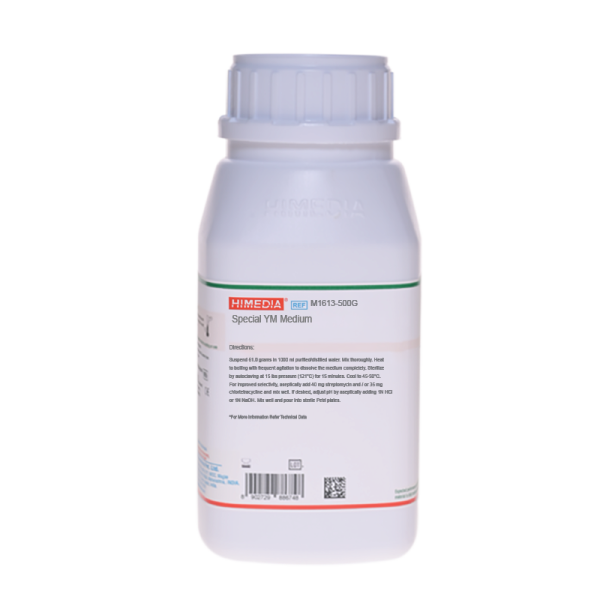 Your enquiry has been submitted
Your enquiry has been submitted
Intended Use
Special Yeast and Mould Medium is used for isolation and cultivation of yeasts and moulds.
Composition**
| Ingredients | g / L |
|---|---|
| Malt extract | 20.000 |
| Peptone | 1.000 |
| Dextrose (Glucose) | 20.000 |
| Agar | 20.000 |
Final pH ( at 25°C) 5.6±0.2
**Formula adjusted, standardized to suit performance parameters
Directions
Suspend 61.0 grams in 1000 ml purified / distilled water. Mix thoroughly. Heat to boiling with frequent agitation to dissolve the medium completely. Sterilize by autoclaving at 15 lbs pressure (121°C) for 15 minutes. Cool to 45-50°C. For improved selectivity, aseptically add 40 mg streptomycin and / or 35 mg chlortetracycline and mix well. If desired, adjust pH by aseptically adding 1N HCl or 1N NaOH. Mix well and pour into sterile Petri plates.
Principle And Interpretation
The three basic structural types of fungi are moulds, yeasts and fleshy fungi (1). These organisms grow on simple nutritive media with an acidic pH. The acidic pH restricts the growth of bacteria.
ACGIH recommended Special YM Medium for the detection and enumeration of fungi (2) with added antibiotics. This medium can also be used for collecting airborne microorganisms (3). Malt extract and peptone provide the required nutrients in the medium. Dextrose is the carbon source. This medium can also be made selective by the addition of antimicrobials.
Type of specimen
Clinical samples skin scrapings, nail scrapings
Specimen Collection and Handling
For clinical samples follow appropriate techniques for handling specimens as per established guidelines (4,5). After use, contaminated materials must be sterilized by autoclaving before discarding.
Warning and Precautions
In Vitro diagnostic use only. For professional use only. Read the label before opening the container. Wear protective gloves/protective clothing/eye protection/face protection. Follow good microbiological lab practices while handling specimens and culture. Standard precautions as per established guidelines should be followed while handling clinical specimens. Safety guidelines may be referred in individual safety data sheets.
Limitations
- As organisms differ in their nutritional requirements, some fastidious organisms may be inhibited or may show poor growth.
- Further biochemical tests must be carried out for complete identification.
Performance and Evaluation
Performance of the medium is expected when used as per the direction on the label within the expiry period when stored at recommended temperature.
Quality Control
Appearance Cream to yellow homogeneous free flowing powder
Colour and Clarity of prepared medium Light to medium amber coloured clear to slightly opalescent gel forms in Petri plates.
Reaction Reaction of 6.1% w/v aqueous solution at 25°C. pH : 5.6±0.2
pH 5.40-5.80
Cultural Response
Cultural characteristics observed after an incubation at 28-32°C for 48-72 hours (Trichophyton mentagrophytes incubated at 30±2°C for upto 7days).
| Organism | Inoculum (CFU) | Growth |
|---|---|---|
| Aspergillus brasiliensis ATCC 16404 (00053*) | 50-100 | good |
| Candida albicans ATCC 26790 | 50-100 | good |
| Enterococcus faecalis ATCC 29212 (00087*) | >=104 | inhibition (on addition of antibacterial agents) |
| Escherichia coli ATCC 25922 (00013*) | >=104 | inhibition (on addition of antibacterial agents) |
| Trichophyton mentagrophytes ATCC 9533 | 50-100 | poor to fair |
Key : *Corresponding WDCM numbers.
Storage and Shelf Life
Store between 10-30°C in a tightly closed container and the prepared medium at 20-30°C. Use before expiry date on the label. On opening, product should be properly stored dry, after tightly capping the bottle in order to prevent lump formation due to the hygroscopic nature of the product. Improper storage of the product may lead to lump formation. Store in dry ventilated area protected from extremes of temperature and sources of ignition Seal the container tightly after use. Product performance is best if used within stated expiry period.
Disposal
User must ensure safe disposal by autoclaving and/or incineration of used or unusable preparations of this product. Follow established laboratory procedures in disposing of infectious materials and material that comes into contact with clinical sample must be decontaminated and disposed of in accordance with current laboratory techniques (4,5).
Reference
- Norton C. F., Microbiology, 2nd Edi, Addison-Wesley Publishing Company.
- Morey P., Otten J., Burge H., Chatigny M. , Feeley J., LaForce F. M. and Peterson K., 1986, Applied Industrial Hygiene 1:R-19.
- Guide regarding condition and attendance of houses, 1990, Finnish Medical Board, Helsinki, Finland.
- Isenberg, H.D. Clinical Microbiology Procedures Handbook 2nd Edition.
- Jorgensen, J.H., Pfaller, M.A., Carroll, K.C., Funke, G., Landry, M.L., Richter, S.S and Warnock., D.W. (2015) Manual of Clinical Microbiology, 11th Edition. Vol. 1.
| Product Name | Special YM Medium |
|---|---|
| SKU | M1613 |
| Customized Product Available | No |



